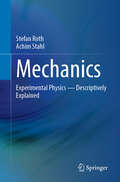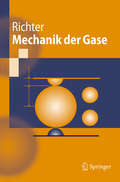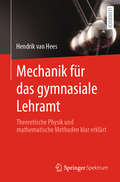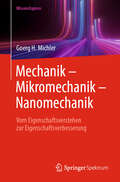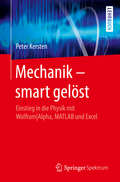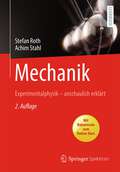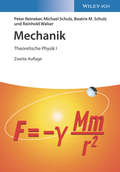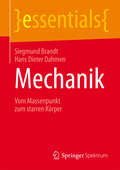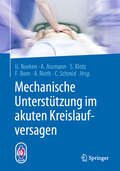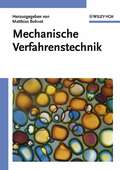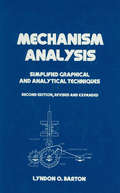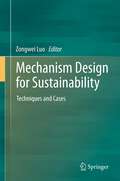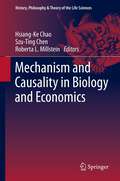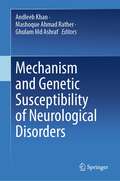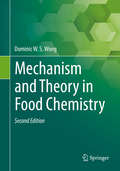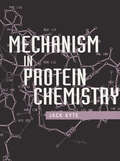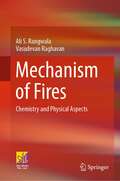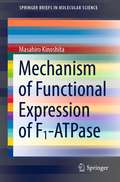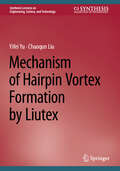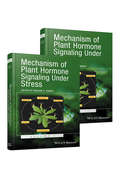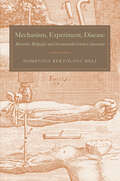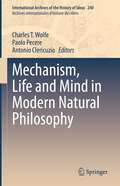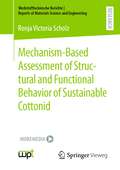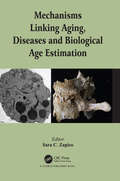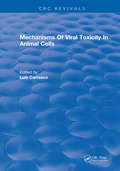- Table View
- List View
Mechanics: Experimental Physics - Descriptively Explained
by Stefan Roth Achim StahlThis modernly designed textbook on experimental physics invites students of physics and neighbouring disciplines to learn mechanics. With clear examples, rich illustrations and modern exercises, the book guides students through the material of the bachelor's course. The authors focus on experiments, which they explain with the help of many illustrations, thus facilitating the understanding of the physical phenomena. The book covers the mechanics of the point masses and rigid and elastic bodies, aero- and hydrodynamics, as well as oscillations and waves.
Mechanik der Gase
by Dieter RichterAusgehend von der Beschreibung der Maxwellschen Geschwindigkeitsverteilung leitet der Autor in dem anwendungsorientierten Lehrbuch die Zustandsgleichung für ideale Gase her und beschreibt die wichtigsten Zustandsgleichungen für reale Gase. Anschließend erläutert er die Beziehungen für alle wichtigen gaskinetischen Kenngrößen und die Möglichkeiten ihrer experimentellen Bestimmung. Der Band bietet eine kompakte Zusammenfassung für Naturwissenschaftler, Ingenieure und Vakuumspezialisten mit vielen Praxisbeispielen, Aufgaben und allen wichtigen Formeln.
Mechanik für das gymnasiale Lehramt: Theoretische Physik und mathematische Methoden klar erklärt
by Hendrik van HeesDieses Lehrbuch in drei Bänden führt in die Standardinhalte der Vorlesungen über Theoretische Physik (klassische Mechanik, Elektrodynamik und Quanten- und Relativitätstheorie) unter besonderer Berücksichtigung der speziellen Bedürfnisse von Lehramtsstudierenden ein. Im Vordergrund stehen dabei die grundlegenden Konzepte basierend auf Symmetrieprinzipien. Der vorliegende 1. Band behandelt die Newtonsche und analytische Mechanik. Besonderheiten Die konzeptionellen Grundlagen der klassischen Mechanik, insbesondere die mathematische Beschreibung von Raum und Zeit sowie der Begriff des Inertialsystems werden sorgfältig herausgearbeitet. Die für das Verständnis der theoretischen Physik unabdingbaren mathematischen Methoden werden parallel zu den eigentlichen physikalischen Lernhinhalten bereitgestellt und alle Rechnungen mit ausführlichen Zwischenschritten vollständig ausgeführt. Neben einer ausführlichen Behandlung der Newtonschen Mechanik mit den üblichen Beispielen zum freien Fall in Erdnähe, dem harmonischen Oszillator und dem Kepler-Problem der Planetenbewegung nimmt das Hamiltonsche Prinzip der kleinsten Wirkung und die ausführliche Behandlung der Symmetrieprinzipien und des Noether-Theorems einen breiten Raum ein. Dies ermöglicht ein vertieftes Verständnis für die moderne Beschreibung der Naturgesetze und erleichtert den Einstieg für die weiterführenden Vorlesungen beträchtlich, insbesondere der Quanten- und Relativitätstheorie. Inhalt 1. Kinematik und Dynamik der Newtonschen Mechanik und Erhaltungssätze, 2. Newtonsches Gravitationsgesetz und Himmelsmechanik, 3. Bewegung in beschleunigten Bezugssystemen, 4. Analytische Mechanik und das Noether-Theorem in Lagrangescher und Hamiltonscher Formulierung, 5. Anwendungen auf die Bewegung starrer Körper und Kreiseltheorie. Zielgruppe Das Buch richtet sich an Bachelor-Studierende der Physik und im Besonderen an Studierende der Physik für das Gymnasiallehramt. Dabei wird dem besonderen Bedarf dieser Zielgruppe einer möglichst einfachen Einführung in die mathematischen Methoden Rechnung getragen. Vorkenntnisse Vorausgesetzt werden Grundkenntnisse der Analysis, der linearen Algebra und der klassischen Mechanik und Eektrodynamik auf Abiturniveau.
Mechanik – Mikromechanik – Nanomechanik: Vom Eigenschaftsverstehen zur Eigenschaftsverbesserung
by Goerg H. MichlerUm das mechanische Verhalten von Werkstoffen einerseits besser zu verstehen und andererseits gezielt verbessern zu können, müssen die Prozesse und Mechanismen, die bei mechanischer Belastung im Material in Abhängigkeit von den Materialstrukturen ablaufen (die sog. „Struktur- Eigenschafts-Korrelationen“), bekannt sein. Grundlegend sind die Prozesse auf mikro- und nanoskopischer Größenebene, d.h. im Größenbereich von 0,1 mm bis herab zu 0,1 nm (d.h. sog. Mikro- und Nanomechanik). Der Autor charakterisiert anschaulich diese mikro- und nanomechanischen Mechanismen mit aussagefähigen Schemata und Bildern auf der Grundlage hauptsächlich von elektronenmikroskopischen Analysen. Neben allgemeingültigen Prozessen und Mechanismen wird auch auf materialspezifische Effekte (z.B. Crazes, Chevrons, Dünnschichtfließen) eingegangen.Die Produktfamilie WissensExpress bietet Ihnen Lehr- und Lernbücher in kompakter Form. Die Bücher liefern schnell und verständlich fundiertes Wissen.
Mechanik – smart gelöst
by Peter KerstenDieses Buch bietet Studierenden in MINT-Fächern eine optimale Hilfestellung beim Erlernen der Grundlagen der Physik. Typische Aufgaben der Mechanik werden dabei Schritt für Schritt erklärt und mit Hilfe leistungsstarker Software aus den Bereichen Tabellenkalkulation, Computeralgebra und technisch-wissenschaftlichem Rechnen gelöst. Die dabei verwendeten Programme (Excel®, der Internetdienst Wolfram|Alpha® sowie die Software MATLAB®) sind sowohl auf Desktop-Rechnern, als auch als Apps auf mobilen Endgeräten wie Smartphones oder Tablets verfügbar – und damit immer schnell zur Hand. Das Fähigkeit mit diesen Programmen zu arbeiten kann auch im weiteren Studienverlauf und später in der beruflichen Praxis von großen Nutzen sein. Nach einer kompakten Einführung in mathematische Methoden und die verwendeten Programme deckt das Buch dabei die Bereiche der klassischen Mechanik mit den Teilgebieten Kinematik und Dynamik ab und liefert somit eine ideale Unterstützung für Einführungsvorlesungen in Physik an Hochschulen. Allen Studierenden, die sich beim Lösen von Aufgaben in der Physik schon einmal eine kleine Hilfestellung gewünscht haben, die einfach mal einen Funktionsverlauf visualisieren, eine Gleichung ohne Papier und Bleistift lösen oder das eigene Rechenergebnis überprüfen möchten, wird das vorliegende Buch ein praktischer und wertvoller Begleiter sein.
Mechanik: Experimentalphysik – anschaulich erklärt
by Stefan Roth Achim StahlDas modern gestaltete Lehrbuch zur Experimentalphysik lädt Studierende der Physik und der Nachbardisziplinen dazu ein, die Mechanik zu erlernen. Mit anschaulichen Beispielen, einer reichen Bebilderung und modernen Aufgaben führt das Buch durch den Stoff der Bachelorvorlesung. Die Autoren legen dabei den Schwerpunkt auf Experimente, die sie anhand vieler Abbildungen erklären, und erleichtern somit das Verständnis der physikalischen Phänomene. Das Buch behandelt die Mechanik des Massenpunktes und des starren Körpers, elastische Körper, Aero- und Hydrodynamik sowie Schwingungen und Wellen.
Mechanik: Theoretische Physik I
by Michael Schulz Peter Reineker Beatrix Mercedes Schulz Reinhold WalserDie Neuauflage deckt die klassischen Gebiete der Mechanik ab, angefangen bei der Kinematik eines Massenpunktes über die Newtonschen Bewegungsgleichungen bis zu den abstrakten Formulierungen der Mechanik (Lagrange 1. und 2. Art, Hamilton'sche Mechanik) und der Relativitätstheorie.
Mechanik: Vom Massenpunkt zum starren Körper (essentials)
by Hans Dieter Dahmen Siegmund BrandtDie Autorenvermitteln die wichtigsten Grundbegriffe der Mechanik, die Newtonschen Gesetzeund aus ihnen abgeleiteten Erkenntnisse. Die Leser lernen die BegriffeGeschwindigkeit, Beschleunigung, Kraft, Energie, Impuls, Drehmoment,Drehimpuls, Leistung und Wirkung kennen. Die Bewegung eines einzelnenMassenpunkts wird an den klassischen Beispielen Pendel, Fall, Wurf undPlanetenbewegung verdeutlicht. Für Systeme mehrerer Massenpunkte gelten unterbestimmten Umständen die Erhaltung von Energie, Impuls und Drehimpuls. Derstarre Körper wird für den Fall seiner Bewegung um eine feste Achse betrachtet. Die Darstellung schließt mit der Diskussion verschiedener Bezugssysteme.
Mechanische Unterstützung im akuten Kreislaufversagen
by Stefan Klotz Udo Boeken Alexander Assmann Frank Born Christof Schmid Andreas RiethZur Überbrückung eines akuten Kreislaufversagens wurden in den letzten Jahren unterschiedliche Unterstützungssysteme mit spezifischen Vorzügen und Nachteilen entwickelt. Das Prinzip, die Indikationen zur Anwendung und mögliche Risiken und Komplikationen aller angewandten Systeme (IABP, Impella, TandemHeart, Zentrifugalpumpen, va-ECMO) sind anschaulich und mit zahlreichen Abbildungen von Experten beschrieben. Grundlagenthemen wie die Pathophysiologie des Schocks und das Gerinnungsmanagement werden ebenso berücksichtigt wie spezielle Anwendungen bei Kindern oder für den Patiententransport.
Mechanische Verfahrenstechnik
by Herausgegeben von Matthias BohnetAuf dem neuesten Stand - die Mechanische Verfahrenstechnik. Die Gliederung des Buches: - Charakterisierung disperser Systeme, - Feststoff/ Fluid-Str mungen, - Mechanische Trennverfahren, - Zerkleinern, - Agglomerieren, - Mischen, - Lagern von Sch ttg tern, - Hydraulischer und pneumatischer Transport, - Moderne Behandlung und Betrachtung der wichtigsten Gebiete der Partikeltechnik. Die Besonderheit dieses Fachgebietes liegt darin, dass in fast allen Verfahren der stoffwandelnden Industrie mechanische Prozesse mit Partikelsystemen eine herausragende Rolle spielen. Und dies bei einer au ergew hnlichen Heterogenit t der Stoffsysteme und Partikelgr en, die acht Zehnerpotenzen umfassen. In Anbetracht der Komplexit t und Spannbreite des Gebietes finden Praktiker in der Industrie, Studenten und Dozenten der Technischen Chemie, der Verfahrenstechnik und des Chemieingenieurwesens in dieser Auskoppelung aus Winnacker-K chler, Band 1 (Wiley-VCH, 2004), eine kompetente Einf hrung aus der Feder von Experten.
Mechanism Analysis: Simplified and Graphical Techniques, Second Edition, (Mechanical Engineering)
by Lyndon O. BartonThis updated and enlarged Second Edition provides in-depth, progressive studies of kinematic mechanisms and offers novel, simplified methods of solving typical problems that arise in mechanisms synthesis and analysis - concentrating on the use of algebra and trigonometry and minimizing the need for calculus.;It continues to furnish complete coverag
Mechanism Design for Sustainability
by Zongwei LuoThis book provides advanced analytics and decision management techniques and tools for developing sustainable competitive advantages in the studied target context. In order to achieve sustainable economy, "the capacity to endure," it is essential to understand and study the mechanisms for interactions and impact from and among these perspectives.
Mechanism and Causality in Biology and Economics
by Szu-Ting Chen Hsiang-Ke Chao Roberta L. MillsteinThis volume addresses fundamental issues in the philosophy of science in the context of two most intriguing fields: biology and economics. Written by authorities and experts in the philosophy of biology and economics, Mechanism and Causality in Biology and Economics provides a structured study of the concepts of mechanism and causality in these disciplines and draws careful juxtapositions between philosophical apparatus and scientific practice. By exploring the issues that are most salient to the contemporary philosophies of biology and economics and by presenting comparative analyses, the book serves as a platform not only for gaining mutual understanding between scientists and philosophers of the life sciences and those of the social sciences, but also for sharing interdisciplinary research that combines both philosophical concepts in both fields. The book begins by defining the concepts of mechanism and causality in biology and economics, respectively. The second and third parts investigate philosophical perspectives of various causal and mechanistic issues in scientific practice in the two fields. These two sections include chapters on causal issues in the theory of evolution; experiments and scientific discovery; representation of causal relations and mechanism by models in economics. The concluding section presents interdisciplinary studies of various topics concerning extrapolation of life sciences and social sciences, including chapters on the philosophical investigation of conjoining biological and economic analyses with, respectively, demography, medicine and sociology.
Mechanism and Genetic Susceptibility of Neurological Disorders
by Ghulam Md Ashraf Andleeb Khan Mashoque Ahmad RatherThis book is about the "Mechanism and Genetic susceptibility of Neurological disorders. It is a comprehensive exploration, penned by esteemed authors, and offers a profound understanding of these enigmatic ailments, their progression, and the strategic approaches employed to mitigate their impact. In this book, readers will uncover a wealth of knowledge surrounding the mechanistic intricacies that underlie various neurological disorders. Through meticulous research and insightful analysis, the authors elucidate the inner workings of these conditions, shedding light on the mechanisms responsible for their onset and progression. The central themes of this book are the recognition of the genetic landscape governing neurological disorders. It emphasizes the role played by a diverse array of genes in the development and progression of these conditions, highlighting the multifaceted genetic susceptibility that underlies their manifestation.
Mechanism and Theory in Food Chemistry, Second Edition
by Dominic W.S. WongFor the first time in over twenty-five years, this unique and popular textbook on food chemistry mechanism and theory has received a full update. Emphasizing the underlying chemical reactions and interactions that occur in foods during processing and storage, this book unifies the themes of "what", "how" and "why" in the language of equations, reactions and mechanisms. This book is the only work which provides in-depth focus on aspects of reaction mechanisms and theories in the chemistry of food and food systems. With more than 500 chemical equations and figures, this book provides unusual clarity and relevance, and fills a significant gap in food chemistry literature. It is a definitive source to consult regarding the important mechanisms that make food components and reactions tick.Mechanism and Theory in Food Chemistry has been a popular resource for students and researchers alike since its publication in 1989. This important new edition contains updates on the original text encompassing a quarter century of advances in food chemistry. Many parts of the original chapters are revised to make for smoother navigation through the subjects, to better explain the underlying chemistry concepts and to fulfill the need of adding topics of emerging importance. New sections on fatty acids, lipid oxidation, meat, milk, soybean and wheat proteins, starch and many more have been incorporated throughout the revision. This updated edition provides an excellent source of all the important chemical mechanisms and theories involved with food science.
Mechanism in Protein Chemistry
by Jack KyteDescribes proteins' physical and chemical nature and how their molecular structures can be determined experimentally. Intended for upper level undergraduate and graduate students with a background in chemistry or biochemistry.
Mechanism of Fires: Chemistry and Physical Aspects
by Ali S. Rangwala Vasudevan RaghavanThis textbook on fire dynamics provides a comprehensive description of fuels involved in fires, definitions related to fire, thermodynamics for fire calculations, basics of transport processes and fundamental aspects of combustion related to fire, physical descriptions of premixed and non-premixed flames, detailed analysis of the characteristics of fires from solid and liquid fuels, including ignition, spread and burning rates and physical aspects of fire plumes, compartment fires and dust fires. The contents also highlight fundamental aspects related to the evaporation of liquid fuels and pyrolysis of solid fuels which are explained with simplified mathematical expressions. The book includes pedagogical features such as worked examples to illustrate mathematical calculations involved in fire analysis and end-of-chapter review questions. This book proves useful for students, researchers and industry professionals alike.
Mechanism of Functional Expression of F1-ATPase (SpringerBriefs in Molecular Science)
by Masahiro KinoshitaThis book presents a new view of the mechanism of functional expression of ATP-driven motors (proteins or protein complexes). It is substantially different from the prevailing idea that the motor converts chemical energy to mechanical work. To facilitate understanding, the differences between the new and prevailing views are explained using many illustrations. The book is of interest to those who are not convinced of the notion of chemo–mechanical coupling. The claims presented are the following: The system, which comprises not only the motor but also water, does no mechanical work during the ATP hydrolysis cycle; a protein is moved or a protein in the complex is rotated by the entropic force generated by water. The highlight of the explanation in the book is that the mechanism of unidirectional rotation of the central shaft in F1-ATPase is discussed in detail on the basis of this new view. The hydration entropy of each β subunit to which a specific chemical compound (ATP, ADP and Pi, Pi, or nothing) is bound, the hydration entropy of the α3β3 complex, and the dependence of the hydration entropy of F1-ATPase on the orientation of the γ subunit play essential roles.
Mechanism of Hairpin Vortex Formation by Liutex (Synthesis Lectures on Engineering, Science, and Technology)
by Chaoqun Liu Yifei YuThis book presents the importance of the mechanism of hairpin vortex formation to understanding flow transition, turbulence, and flow control. This book blends direct numerical simulation (DNS) and mathematical analysis with experiments to create a foundation for understanding turbulence. The authors discuss hairpin vortex as a main component of transitional flow and turbulent flow. In addition, Liutex is utilized and described as a theoretical system that presents valid tools for turbulence research. Readers are exposed to understanding 3D and non-linear instability; the Lambda vortex formation; sweeps, ejections, and shear instability; the Kelvin-Helmholtz instability and vortex ring formation; and turbulence generation and sustenance.
Mechanism of Plant Hormone Signaling under Stress
by Girdhar K. PandeyPlant hormone signaling plays an important role in many physiological and developmental processes including stress response. With the advent of new post-genomic molecular techniques, the potential for increasing our understanding of the impact of hormone signaling on gene expression and adaptive processes has never been higher. Unlocking the molecular underpinnings of these processes shows great promise for the development of new plant biotechnologies and improved crop varieties. The topics included in this book emphasize on genomics and functional genomics aspects, to understand the global and whole genome level changes upon particular stress conditions. With the functional genomics tools, the mechanism of phytohormone signaling and their target genes can be defined in a more systematic manner. The integrated analysis of phytohormone signaling under single or multiple stress conditions may prove exceptional to design stress tolerant crop plants in the field conditions. Bringing together the latest advances, as well as the work being done to apply these findings to plant and crop science, Mechanism of Plant Hormone Signaling Under Stress will prove extremely useful to plant and stress biologists, plant biotechnology researchers, as well as students and teachers.
Mechanism, Experiment, Disease: Marcello Malpighi and Seventeenth-Century Anatomy
by Domenico Bertoloni MeliA leading early modern anatomist and physician, Marcello Malpighi often compared himself to that period’s other great mind—Galileo. Domenico Bertoloni Meli here explores Malpighi’s work and places it in the context of seventeenth-century intellectual life.Malpighi’s interests were wide and varied. As a professor at the University of Bologna, he confirmed William Harvey’s theory of the circulation of blood; published groundbreaking studies of human organs; made important discoveries about the anatomy of silkworms; and examined the properties of plants. He sought to apply his findings to medical practice. By analyzing Malpighi’s work, the author provides novel perspectives not only on the history of anatomy but also on the histories of science, philosophy, and medicine. Through the lens of Malpighi and his work, Bertoloni Meli investigates a range of important themes, from sense perception to the meaning of Galenism in the seventeenth century. Bertoloni Meli contends that to study science and medicine in the seventeenth century one needs to understand how scholars and ideas crossed disciplinary boundaries. He examines Malpighi’s work within this context, describing how anatomical knowledge was achieved and transmitted and how those processes interacted with the experimental and mechanical philosophies, natural history, and medical practice. Malpighi was central in all of these developments, and his work helped redefine the intellectual horizon of the time. Bertoloni Meli’s critical study of this key figure and the works of his contemporaries—including Borelli, Swammerdam, Redi, and Ruysch—opens a wonderful window onto the scientific and medical worlds of the seventeenth century.
Mechanism, Life and Mind in Modern Natural Philosophy (International Archives of the History of Ideas Archives internationales d'histoire des idées #240)
by Charles T. Wolfe Paolo Pecere Antonio ClericuzioThis volume emphasizes the diversity and fruitfulness of early modern mechanism as a program, as a concept, as a model. Mechanistic study of the living body but also of the mind and mental processes are examined in careful historical focus, dealing with figures ranging from the first-rank (Bacon, Descartes, Spinoza, Cudworth, Gassendi, Locke, Leibniz, Kant) to less well-known individuals (Scaliger, Martini) or prominent natural philosophers who have been neglected in recent years (Willis, Steno, etc.). The volume moves from early modern medicine and physiology to late Enlightenment and even early 19th-century psychology, always maintaining a conceptual focus. It is a contribution to a newly active field in the history and philosophy of early modern life science. It is of interest to scholars studying the history of medicine and the development of mechanistic theories.
Mechanism-Based Assessment of Structural and Functional Behavior of Sustainable Cottonid (Werkstofftechnische Berichte │ Reports of Materials Science and Engineering)
by Ronja Victoria ScholzRonja Victoria Scholz assesses the performance of cellulose-based Cottonid for implementation as sustainable construction material. Quasi-static and fatigue tests are performed in varying hygrothermal test conditions using mechanical testing systems in combination with integrable climate chambers. To investigate humidity-driven actuation properties, customized specimen holders are designed. Accompanying microstructural in situ experiments in analytical devices enable a profound understanding of effective material-specific damage and failure mechanisms. The findings are transferred into strength-deformation diagrams as well as Woehler curves, which enable a comparative evaluation of several process-related and environmental influencing factors and can directly be used for dimensioning of Cottonid elements for structural applications. The interpretation of thermoelastic material reponse during loading is used as scientific value for lifetime prediction. Comprehensive investigations on industrial standard materials as well as structurally optimized Cottonid variants provide a scientific basis for categorizing material’s structural and functional performance towards common technical plastics and wood.
Mechanisms Linking Aging, Diseases and Biological Age Estimation
by Sara C. ZapicoThis book focuses on four of the hallmarks of aging: aspartic acid racemization, advanced glycation end products, telomere shortening and mitochondrial mutations; describing their role in aging and diseases; and their application to age-at-death estimation in forensic sciences in greater depth, displaying the interconnecting pathways among these processes. An additional chapter related to Epigenetics and its role in aging, diseases, and forensic age estimation is also included. This book is aimed at a broad audience: from students being introduced to aging, diseases, and forensic science research to scientists in biomedicine and forensics complementing their knowledge in their respective fields while also increasing their knowledge in other disciplines.
Mechanisms Of Viral Toxicity In Animal Cells
by Luis CarrascoThe present book is intended to give an account of the state of the art on how animal viruses induce cytotoxic effects in cells.
